Handling heritage objects
Janet Mason
Handling heritage objects is part of CCI’s Preventive conservation guidelines for collections online resource. This section presents key preventive conservation considerations for safe handling practices with regards to heritage collections.
Table of contents
- Handling: key considerations
- Strategies for safe handling of objects
- Prior to handling
- Support, lift and move objects
- Secure or immobilize elements and moving parts
- Where to place hands
- Use rigid flat supports and trays
- Provide supports
- Be aware of attachments, handles, old repairs
- Multiple handlers
- Lifting specific types of objects
- Moving objects a short distance
- Selecting wheeled equipment for moving objects
- Ensure security
- Report damage
- Bibliography
List of abbreviations
- CCI
- Canadian Conservation Institute
- HEPA
- high efficiency particulate air
- portable document format
- PVC
- poly(vinyl chloride)
- UBC
- University of British Columbia
Handling: key considerations
Handling heritage objects and collections with care is an important aspect of their long-term preservation. Two main considerations to keep in mind when handling objects are the risks involved for the objects and the risks that the objects may pose to the handler. Handling protocols of sacred or culturally sensitive objects should also be observed. Consult Caring for sacred and culturally sensitive objects for information on the importance of consultation in order to identify and develop handling protocols.
Handling: risks to heritage objects
Heritage objects are at their most vulnerable when being handled.
When groups of objects are examined, the most prevalent damage observed is usually the result of impact—dents, scratches, cracks and breaks (Figure 1). Damages like these commonly occur during an object’s original (historical) use and provide evidence of use that might be of value to researchers. However, once an object comes into a collection, it must be protected from further damage.

© Government of Canada, Canadian Conservation Institute. CCI 124703-0084
Figure 1. Watercolour on an acidic card. Weak materials are easily damaged when carelessly handled.
With training and planning, it is possible to anticipate problems and develop methods for the safe handling and movement of objects, thus reducing the risk of additional damage.
Physical forces
Breaks, cracks, chips, losses, deformation and surface abrasion are all evidence of dropping, knocking or even improper placement of hands when lifting fragile objects. The extent of damage depends on the type of materials and their condition. Typically, more brittle materials suffer more damage than flexible ones, but the weight of objects and the height from which they are dropped all have an influence in that regard (further details about physical forces as an agent of deterioration can be found under Agent of deterioration: physical forces).
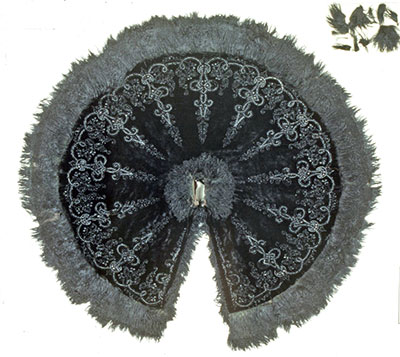
© Government of Canada, Canadian Conservation Institute. CCI 2005467-0001
Figure 2a. This beaded, black velvet cape from the late 19th or early 20th century appeared to be in good condition overall, but a closer examination of its fur trim and collar revealed that the fur was so weak that it was at risk of tearing when handled.
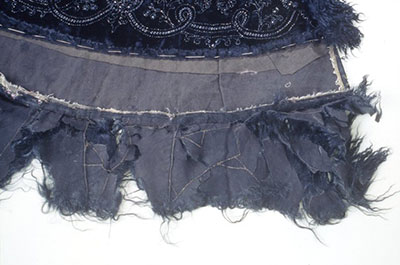
© Government of Canada, Canadian Conservation Institute. CCI 2005467-0002
Figure 2b. Detail of the black fur trim during treatment. During treatment, the fur was partly unstitched from the rest of the cape and, when flipped over on its back side, revealed numerous tears.
Objects may appear to be strong to the untrained eye, but they may conceal weaknesses or unanticipated deterioration:
- Materials might have become fragile due to their aging and subsequent deterioration, e.g. some historical black-dyed leathers and furs can be extremely degraded to the point of tearing under their own weight (Figures 2a and 2b).
- Visually intact surfaces can hide very fragile interiors, such as a piece of wood that has been tunnelled by insects but has an intact skin, or outer layer. A surface that fools the eye has potential to fool the hands. Even when carefully handling an object, pressure, albeit minimal, is applied at the point of contact, which can cause damage if the object is very fragile in this area.
- Joints, ties, adhered components, etc. may be damaged, worn or loose. Often, weaknesses at joints and points of assembly are not conspicuous until closely inspected (Figures 3 and 4).

© Government of Canada, Canadian Conservation Institute. CCI 125773-0008
Figure 3. A coffee pot that needs to be moved stands on a counter.

© Government of Canada, Canadian Conservation Institute. CCI 125773-0009
Figure 4. Handles, which are used frequently, can be weakly attached. For this reason, they are often the weakest element of an object. In this case, the coffee pot handle came off when the handler attempted to use it to lift the object. Examine an object before moving it.
Lifting objects without adequate support can cause damage. For example, a ceramic vessel with incipient cracks may break apart if not properly supported when handled. Weakened materials in an object may no longer be able to support their own weight or the weight of attachments and protruding components. For example, an ornate silk object may be too weak to support the weight of attached decorative elements when lifted without a support; the elements will pull at the point of attachment and cause the fabric to tear (Figure 5). The object needs complete support to prevent damage when being moved.

© Government of Canada, Canadian Conservation Institute. CCI 125773-0023
Figure 5. A dance costume from the early 1900s shows silk fibres that have torn from the weight of attached decorative elements.
Wheeled transporting devices, such as dollies or carts, are commonly used, but they can jostle unsupported objects, which may cause damage to very fragile objects, e.g. weakly bonded paint layers (Figure 6) or adhesive joints may separate. Cracks already present on an object may extend, or there may be movement of loosely attached components that stress the point of attachment, such as weak hinges on doors. Padding, securing ties and other possible solutions to these problems are discussed under Support, lift and move objects.

© Government of Canada, Canadian Conservation Institute. CCI 124769-0028
Figure 6. Detail of a Chinese lion dance costume. The weakly bonded paint separated, causing flaking and losses, probably due to abrupt movements during handling.
Contaminants
Natural salts and oils from hands can mark clean surfaces, even though this may not be immediately noticeable.
Objects particularly sensitive to damage from this type of contamination when handled with bare hands include:
- metal surfaces: polished silver, copper and brass (Figures 7, 9 and 10)
- gilded surfaces (Figure 8)
- photographs, which can easily be marred because most photographic surfaces are extremely absorbent and hygroscopic
Glossy surfaces, such as glass or highly polished stone, may hold fingerprints. Even though the salts and oils may not react unfavourably with these surfaces, additional and otherwise unnecessary cleaning or polishing will be needed to improve the appearance.

© Government of Canada, Canadian Conservation Institute. CCI 120260-0065
Figure 7. A clear fingerprint on brass due to touching with bare hands.

© Government of Canada, Canadian Conservation Institute. CCI 125773-0025
Figure 8. Gilded surfaces should be handled with gloves. This image shows a gold-painted frame rather than gilt; nevertheless, if the surface is unfamiliar, the handler should always wear gloves.

© Government of Canada, Canadian Conservation Institute. CCI 125773-0003
Figure 9. Even though the silver-plated goblet is tarnished, it should be handled with gloved hands.

© Government of Canada, Canadian Conservation Institute. CCI 125773-0004
Figure 10. Wear gloves (nitrile seen here) when handling metal objects.
Applied pressure to unclean surfaces (dusty, soiled) can cause dirt to be forced more deeply into a substrate. If the pressure is applied by hands, the perspiration and oils fix the dirt in place, especially on porous or rough surfaces.
Handling: risks to handler
The other side of handling is the potential effect of the objects on the handler. Certain kinds of objects may present hazards that are inherent to their constituent materials and how these degrade, e.g. radioactive luminous dials (Warren 2010), corroded lead (Figure 11), some plastics (Tsang 2010), some ethnobotanical specimens (Kubiatowicz and Benson 2003). Others may contain hazards acquired during their history or use, e.g. objects contaminated with mould (Figure 12) and those that contain pesticide residues (Sirois, Poulin and Stone 2010). All of these have the potential to affect the health of the handler.
Consult CCI Technical Bulletin 26 Mould Prevention and Collection Recovery: Guidelines for Heritage Collections for more information on health effects relating to mould exposure.

© Government of Canada, Canadian Conservation Institute. CCI 121755-0017
Figure 11. This marionette has corroded lead components (the fingers). The object was labelled, bagged and isolated from other materials to contain the hazardous contaminant prior to treatment.

© Government of Canada, Canadian Conservation Institute. CCI 123238-0017
Figure 12. Mould on a book.
Strategies for safe handling of objects
The following are strategies for day-to-day handling and short moves of objects within a building.
Prior to handling
Handling can easily be a source of physical damage, so avoid handling whenever possible. When handling is needed, forethought and planning are required no matter the object or the distance of the move.
Understand the object
An important first step is to thoroughly examine the object before any handling to determine the strong and weak areas. Some objects are so fragile (e.g. objects with flaking or powdery paint) that they should be handled as little as possible or they may need special handling precautions to be moved safely. For complex objects, condition reports should be consulted, if available, and updated as necessary. The object should be examined closely with the following considerations in mind:
- Is the surface intact or are some areas poorly attached?
- Are there parts that risk falling off if the object is moved from its present position?
- Is the surface dirty or mouldy?
- Will personal protective equipment be needed?
- Are there any movable parts or components that are weakly attached?
- How heavy is the object?
- How many people will be needed to lift and move the object safely?
- Will the object be safer if a support or a padded tray is provided for the move?
Clear the way
To move an object, the path from its present location to its new location should be known in advance and, if necessary, checked before the move begins. An abstract familiarity with the route cannot be used to predict recent obstructions.
Consider the following steps when planning a route:
- Prepare the new location. It should be clean, large enough for the object and have padding in place if needed (Figure 13).
- Clear the pathway and open doors or arrange help to aid passage.
- Check heights and widths of doors for clearance.
- Ensure that there is adequate space to turn corners.
- Remove obstacles or hazards on the floor or items hanging from the ceiling.

© Government of Canada, Canadian Conservation Institute. CCI 125773-0044
Figure 13. Padded blocks were put on the floor next to a wall before placing this painting on them, in between two protective cardboard panels, for temporary storage.
Prepare the handlers
Protection for the object
The handlers should remove any items that might scrape or catch on objects such as rings, bracelets, watches, pendants or belt buckles.
Protection for the handler
Handlers need to be aware of whether the objects to be handled pose a risk. If dealing with hazardous materials or if in doubt, handlers must wear appropriate protective equipment, such as HEPA (high efficiency particulate air) filter masks, gloves, coveralls, aprons, lab coats and protective shoes (Figure 14).

© Government of Canada, Canadian Conservation Institute. CCI 125773-0005
Figure 14. Some mounted natural history specimens might have been prepared with, or later treated with, toxic materials. If the specimen’s history is unknown, handle it as if it were contaminated with a hazardous material. Wear protective gloves, a mask and a lab coat or coverall.
Common examples of hazardous materials include mouldy materials; powdery materials which may release fine, loose particulates into the air when moved; pesticide residues (e.g. from older taxidermy specimens or objects previously treated with insecticides); lead containing particles; and chemical residues on pharmaceutical and medical objects. Consult Conserv O Gram 2/19, Guidelines for the Handling of Pesticide Contaminated Collections (PDF version, 231 KB) for more details on these health and safety issues.
Limit contamination
Gloves: pros and cons
As mentioned above, gloves are required to protect handlers where there is a health and safety risk of contamination.
There are certain types of materials and surfaces that should always be handled with gloves to protect the object. These include metals, gilded surfaces, photographic documents (prints, negatives, slides and motion picture films), highly polished surfaces and powdery (deteriorated leather, etc.) or dirty surfaces (consult Contaminants for more information on these materials).
The practice of handling all objects with gloves shows an attitude of care and regard for the heritage value of the objects. There are, however, certain circumstances where gloves can reduce the sensitivity of touch and are therefore not recommended. The potential for damage from insensitive and insecure handholds on a particular object must be weighed against the potential for contamination from salts and oils from hands.
If unsure of the risk, thin and close-fitting gloves provide the best solution, allowing dexterity with limited reduction of sensitivity to touch while also protecting surfaces. Figure 15 shows a selection of glove types, and Table 1 provides a comparison between different types of gloves and their advantages and disadvantages.

© Government of Canada, Canadian Conservation Institute. CCI 125773-0031
Figure 15. A variety of glove types. From left to right: inexpensive cotton, cotton with grip nodules, better quality cotton, nylon, polyethylene, latex and nitrile.
Table 1: types of gloves available for handling objects and their advantages and disadvantages
| Type of glove | Sensitivity to touch / grip quality | Transfer of salt and oils | Protection for handler | Comfort and fit | Comments |
|---|---|---|---|---|---|
|
No gloves (bare hands) |
Excellent |
Yes |
None |
Excellent |
Hands must have been recently washed and dried with no uncovered cuts; certain materials and surfaces should not be handled with bare hands |
|
Cotton |
Fair; slips on smooth surfaces |
No transfer of oils and salts (unless gloves are extensively used without washing) |
Minimal |
Fit varies (form and fabric vary); comfortable for long-term use |
Reusable but must be regularly washed |
|
Cotton with grip nodules (Figures 16 and 17) |
Poor sensitivity but good grip |
No transfer of salts and oils but transfers plasticizers if nodules are made of poly(vinyl chloride) (PVC) |
Minimal |
Generally a better fit of cotton glove; comfortable for long-term use |
Gripping nodules may be made with PVC and leave plasticizer on surfaces (some brands cause tarnish on metals, as shown in Figure 18); gloves can be washed and reused but nodules will eventually degrade |
|
Polygenex nylon |
Fair |
No transfer of oils and salts |
Minimal |
Similar fit to better quality cotton; comfortable for long-term use |
Gloves do not scratch surfaces and are suggested for handling all photographic film materials; nylon dissipates static; gloves are |
|
Nitrile |
Good; |
No transfer of oils and salts |
Good protection from particulates and many chemicals |
Thin and can fit the hand closely (available in several sizes); hand sweats inside glove |
Non-powdered gloves that have undergone a chlorination process should not be used; use those that have an interior application of polymer; disposable (not designed for reuse) Some types of nitrile gloves can tarnish silver; consult Caring for metal objects for more details |
|
Latex |
Good; |
No transfer of oils and salts |
Good protection from particulates and from some chemicals |
Thin and can fit the hand closely (available in several sizes); hand sweats inside glove |
Can trigger allergic reactions in some people; can degrade more quickly than nitrile gloves; disposable (not designed for reuse) |
|
Polyethylene (one size) |
Poor because of very bad fit; can slip on smooth surfaces |
No transfer of oils and salts |
Protection from particulates and some chemicals |
Thin but does not have a close fit and has limited elastic quality; awkward to wear |
Disposable (not designed for reuse) |
|
PVC |
Fair; thin but not as flexible as the latex or nitrile, so the fit is not as good |
No transfer of oils and salts but transfers PVC plasticizers |
Protection from particulates and some chemicals |
Hand sweats inside glove; fit is fair/poor |
PVC should not be used or stored near collections because the plastic degrades and leaves corrosive sticky residues on objects in contact; gloves are disposable (not designed for reuse) |
|
Rubber |
Poor; thick plastic that does not closely fit the hand |
No transfer of oils and salts |
Protection from particulates and some chemicals; can withstand some abrasion |
Hand sweats inside glove; poor fit |
Can withstand frequent use but will become soiled |
|
Combination (plastic with cotton inside) |
Fair; reduced sensitivity but does not slip on smooth surfaces if latex or nitrile glove is used over the cotton |
No transfer of oils and salts |
Protection varies with the type of plastic glove worn over the cotton glove |
Good quality cotton and properly sized latex or nitrile glove will give a fair/good fit; the addition of a cotton glove improves comfort for extended use |
Cotton glove on inside can be reused; plastic glove is disposable (not designed for reuse) |

© Government of Canada, Canadian Conservation Institute. CCI 120260-0056
Figure 16. Sure Grip cotton gloves with white PVC dots (or nodules).

© Government of Canada, Canadian Conservation Institute. CCI 120260-0056
Figure 17. Detail of PVC dots.

© Government of Canada, Canadian Conservation Institute. CCI 125773-0027
Figure 18. Sterling silver showing a transfer of the dot pattern.
Figures 16 to 18: An experiment was carried out at CCI to check if gloves made with PVC nodules pose a risk for objects. Sterling silver (92.5% silver and 7.5% copper) was tested because this alloy reacts rapidly with many harmful agents and the result is visible to the naked eye. The sterling silver sheet was placed in direct contact with a Sure Grip cotton glove (Figure 16). After exposure to direct sunlight for nine weeks, the glove’s grip nodule pattern (shown in Figure 17) had transferred to the sterling silver (Figure 18). This indicates that the grip nodules transferred a material that could corrode the alloy. The conclusion is that it is best to avoid using this type of glove for handling objects.
Limit the handling of dirty objects
Objects covered with dust or soot should be handled as little as possible. When dirty surfaces are handled, the dirt is often pushed further into the surface and compacted by hand pressure (Figure 19). Porous surfaces are especially difficult to clean because the dirt enters small interstices.

© Government of Canada, Canadian Conservation Institute. CCI 125773-0014
Figure 19. Handling dirty surfaces with bare hands can press dirt and skin oils into the surface and create areas that are more difficult to clean.
Objects made of materials which are supple and cover a large surface area, such as furs, feathers and textiles, should be moved as little as possible until the dirt is removed. Unnecessary movement may cause fine particles to be driven further into the structure.
Removal of surface dust and dirt should be considered prior to moving since:
- clean objects are usually easier to handle and there are generally fewer health and safety risks
- the surface condition can be seen
- dirt will not be pushed into the surface
- dust and dirt will not be transferred to another area
- a clean object, to most people, will have more significance and they will instinctively handle it more carefully than if it was dirty (although this should not have any relevance on the quality of care provided to the object)
If prior cleaning is not possible, placing the object in a box or covering it with tissue or plastic sheeting will minimize direct surface contact and will contain loose dust as the object is moved.
Support, lift and move objects
Secure or immobilize unstable elements and moving parts
Multiple components of an object should move as one, unless they can be separated and each piece moved individually (e.g. furniture drawers or lids). Any loose parts and any free-moving but attached sections (e.g. hinged) need to be immobilized. This should be done by securing the part to the object itself or to the object’s support. Examples of components that should be secured are doors that cannot be latched, broken material that is loosely attached and torn or loose coverings.
Cloth tapes or belts are useful to bind objects as they have soft surfaces and are flexible (Figure 20). Band clamps might also be used for larger objects, but only sufficient pressure should be applied to secure the object, and any pressure point should be padded beneath the bands (e.g. foam blocks or blankets at the corners).
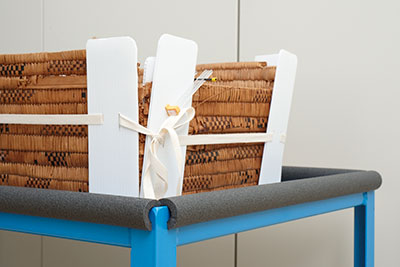
© Government of Canada, Canadian Conservation Institute. CCI 86568-0004
Figure 20. A fragile basket is secured with twill tape and Coroplast supports prior to being moved.
The interior of objects should be checked and any loose interior parts stabilized (removed, tied down or padded). A good example is the removal of suspended weights and pendulums prior to moving long-case clocks.
Where to place hands
Use both hands to carry one object at a time. One hand can be placed higher on the object to provide balance, while the other hand can be placed at the base to support its weight (Figures 21 to 24). If the object is to be transferred to another person, it should be placed on a solid surface and then transferred, rather than being transferred from hand to hand.

© Government of Canada, Canadian Conservation Institute. CCI 125773-0006
Figure 21. In this example of an object being carried with one hand, the object’s weight is not supported and stress is placed on a weak part of it, i.e. the cord.

© Government of Canada, Canadian Conservation Institute. CCI 125773-0007
Figure 22. To properly carry an object, support its heaviest part with one hand and use the other hand to hold another part of it for balance. For best touch sensitivity on materials that do not react to salts or oils from hands, handle with bare hands that have been recently washed and dried.

© Government of Canada, Canadian Conservation Institute. CCI 125773-0024
Figure 23. This unframed painting is carried by two people, each supporting the weight with one hand at the bottom edge and placing the other hand at the back and side of the painting to keep it balanced.
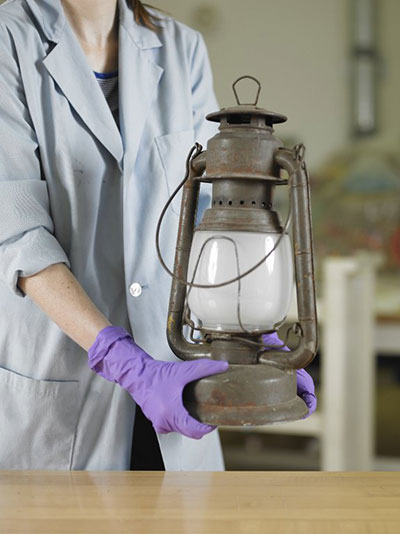
© Government of Canada, Canadian Conservation Institute. CCI 125773-0001
Figure 24. Gloved hands (nitrile gloves shown here) are used to carry an iron and glass lantern at its base.
Use rigid flat supports and trays
Hands can only span and support a small area, which may be adequate for supporting small objects or larger strong and rigid ones. Strong, flexible objects may also be able to tolerate the support that hands (and occasionally arms) provide for a short period of time, such as a garment being lifted from a worktable (Figure 25) and moved close by.
In general, though, flexible items such as paper, textiles, skins and hides require full support (Figure 26).
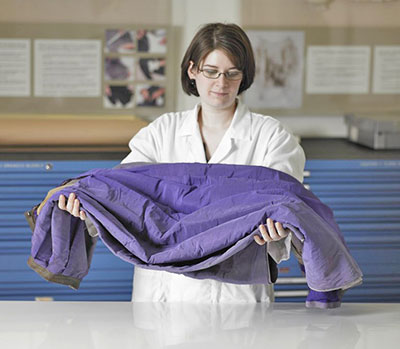
© Government of Canada, Canadian Conservation Institute. CCI 125773-0020
Figure 25. A structurally stable garment is lifted from a work surface to be moved close by.

© Government of Canada, Canadian Conservation Institute. CCI 124703-0085
Figure 26. Moving a paper object on a rigid support.
Fragile materials, whether rigid or flexible, also require an even support that hands cannot provide. A rigid support should be inserted under the object; the support can then be handled rather than the object.
The strength of the support needed will be dictated by the weight of the object. A sheet of paper or a light textile item can be supported on a piece of 4-ply matboard. An object of light to medium weight might need a fluted plastic sheet or a rigid foam base, while plywood might be useful for heavier items. Flat supports can be slipped under objects. Trays or bins are useful if the objects can be lifted and carried in them (Figure 27).
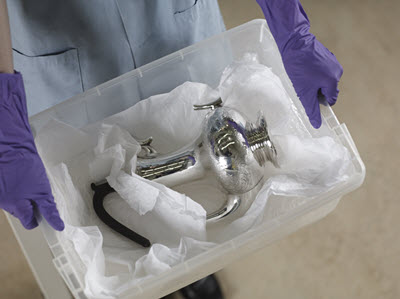
© Government of Canada, Canadian Conservation Institute. CCI 125773-0010
Figure 27. A silver-plated coffee pot and a detached handle are carried in a plastic bin padded with tissue.
Provide supports
Permanent supports for storage and handling provide the best solution; they will serve as long-term protection and will reduce the hazards of handling and the preparation time required for moving objects (Figures 28 to 31). The object will be fully supported, and the handler may never need to touch the object.
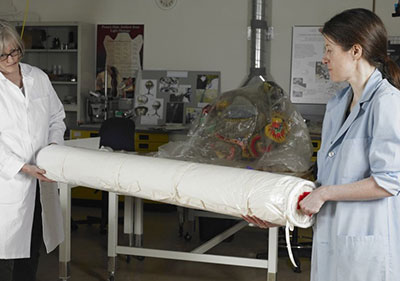
© Government of Canada, Canadian Conservation Institute. CCI 125773-0016
Figure 28. Flat flexible objects can be rolled on a padded tube for transport or storage. For more details, see CCI Note 13/3 Rolled Storage for Textiles.
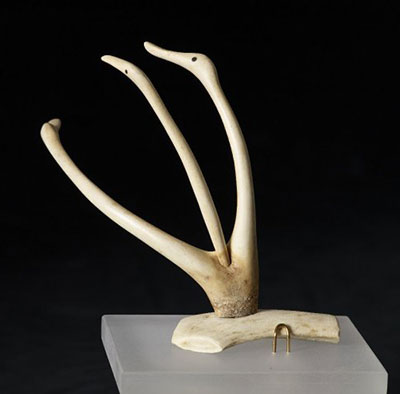
© Government of Canada, Canadian Conservation Institute. CCI 123310-0009
Figure 29a. An antler sculpture of three geese is secure on its display mount but requires additional protection during handling because the middle antler tine is mobile and, if not retained, could slip out of place (if the object is tilted, etc.).
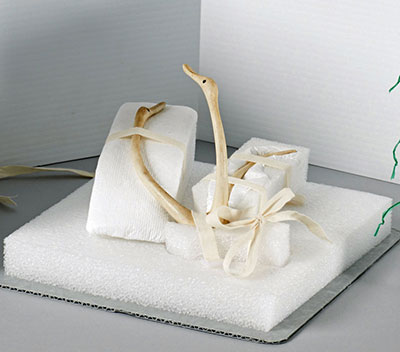
© Government of Canada, Canadian Conservation Institute. CCI 123310-0015
Figure 29b. Detail of a storage mount. This mount also allows for the safe movement of the small antler sculpture as it holds components in place in the foam mount.
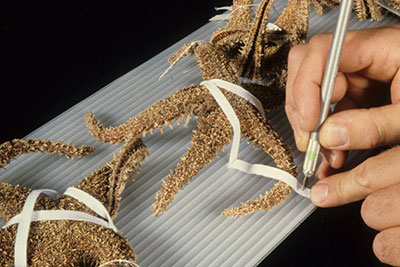
© Government of Canada, Canadian Conservation Institute. CCI 125773-0043
Figure 30. Objects can be immobilized with cloth tape on a fluted plastic board. The tape is pushed into knife-cut slots in the board with a thin-wedged instrument.
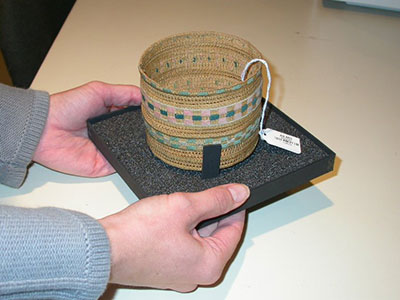
Courtesy of the Museum of Anthropology at UBC, Vancouver, Canada. Basket A2.593; Heidi Swierenga, photographer
Figure 31. A basket is carried on a foam support. Tabs attached to the support hold the basket in place while it is being moved.
Be aware of attachments, handles, old repairs
Attachments as well as protruding parts of an object that were intended as handholds to move or lift it might have been weakened by extensive use or a poor repair prior to the object being collected. They may no longer be able to support the weight of the object if used to grasp or lift it. If a break occurs while lifting, the rest of the object may be damaged if it drops to the ground. Convenient handholds, used frequently in the past to lift the object, should always be suspected of being fragile. For example, chairs should be lifted at the seat rail and not at the back or arms (Figures 32 and 33). Lifting by any projection attached to the top of an object will result in all the weight being concentrated at this point, thus risking fracture (Figure 34). The weight of objects should be supported from the base (Figure 24).
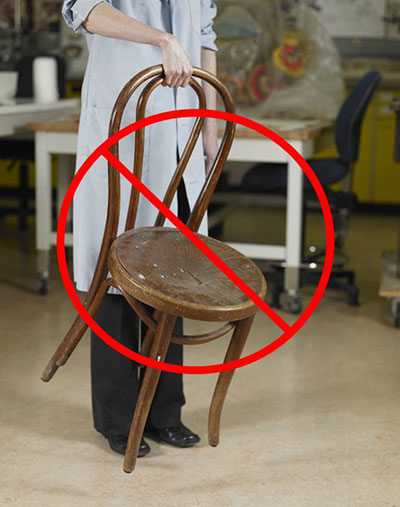
© Government of Canada, Canadian Conservation Institute. CCI 125773-0012
Figure 32. Avoid lifting chairs from the top of the back.
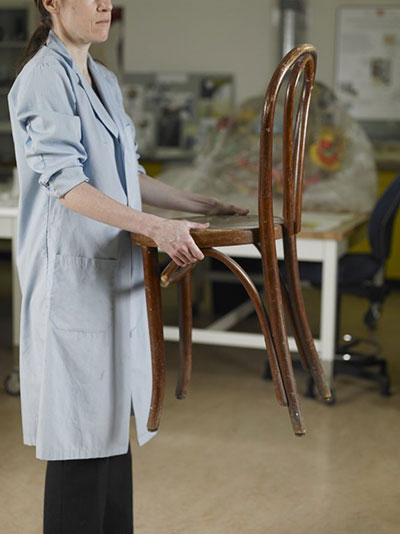
© Government of Canada, Canadian Conservation Institute. CCI 125773-0013
Figure 33. To safely carry a chair, grasp each side of the seat and lift.
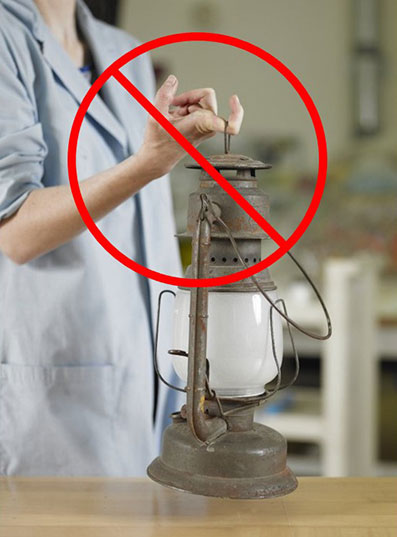
© Government of Canada, Canadian Conservation Institute. CCI 125773-0002
Figure 34. Do not carry an object by a handle or another element attached to its top. In this case, it is not advisable to carry the lantern by the top ring, as this puts all of the lantern’s weight on the ring, which could be only weakly attached to the rest of the object. Also, wear gloves when handling metal objects.
Multiple handlers
Objects should always be lifted, never dragged, which requires having enough personnel on hand for the lifting. One person should act as the lift leader to talk through the lift and move, ensuring that safe handholds are known by everyone, and that all handlers are ready to carry out instructions at the same time. Movements need to be coordinated, and the object needs to be monitored as it is being moved. This is especially important if the object cannot be moved on a cart or trolley (e.g. if stairs must be used).
Lifting specific types of objects
When handling wet objects (e.g. objects affected by leaks or floods), allowances must be made for absorbed liquids that increase the weight of the object. The material may not be able to support the additional weight, and the water might weaken the material or structure. Support the object as much as possible, preferably using a solid support.
Lift heavy or large objects, such as a piece of furniture or a sculpture, near the base using strong and solid areas as handholds (Figure 35). Bend the knees and hold the object close to the body. A heavy object should only be lifted for a brief period, so ensure that a cart or dolly is standing nearby. Very heavy objects should be moved with appropriate equipment (forklift, pump truck or small crane) and by experienced handlers.
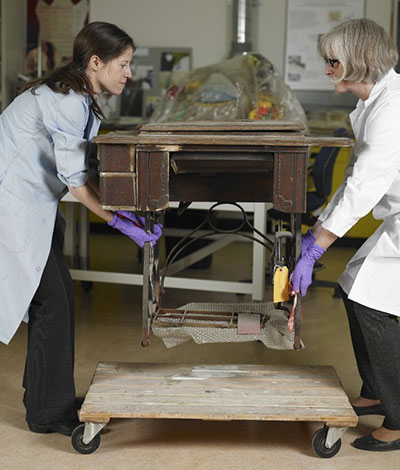
© Government of Canada, Canadian Conservation Institute. CCI 125773-0015
Figure 35. This treadle sewing machine table was lifted appropriately at the cast iron base with gloved hands.
When lifting bagged objects, the layout, weakness and shape of the contents should be determined and a solid handhold established (Figure 36). Bare hands or close-fitting plastic gloves should be used when lifting bagged objects, as the surfaces of the bags may be slippery.
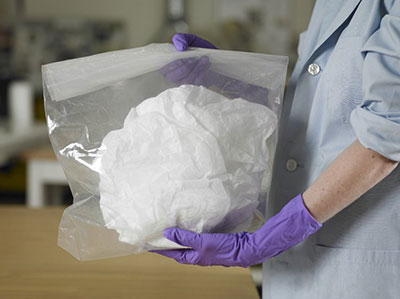
© Government of Canada, Canadian Conservation Institute. CCI 125773-0011
Figure 36. Support the base of bagged items and use nitrile gloves or bare hands to ensure a good grip.
Any flat surface that has loosely attached components, such as poorly bound pigments or flaking paint, should be carried and stored horizontally to prevent loss.
Moving objects a short distance
Good building design can simplify the safe movement of objects enormously. Highly desirable features include level floors, separate freight elevators, ramps, loading docks with dock levellers, wide doors and adequate space for movement within storage areas.
For short trips, a tray is useful for moving one or several smaller objects with low centres of gravity. The interior of the tray should be padded with a foam sheet that provides cushioning as well as a surface that prevents sliding. Small objects with high centres of gravity are better carried by hand or in padded boxes.
A cardboard box or a plastic container with padding around each object may be useful as temporary housing during a move. If several objects are moved in one container, it is important that each be separated with padding to prevent damage through contact (Figure 37). Objects should not be placed one on top of the other.
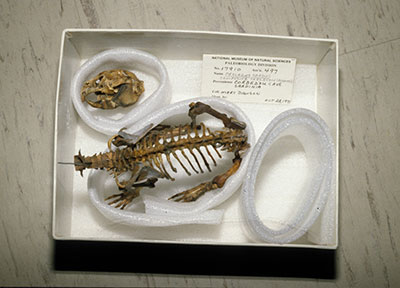
© Government of Canada, Canadian Conservation Institute. CCI 125773-0119
Figure 37. These fossils are individually surrounded with polyethylene foam rings (i.e. padding) to prevent them from bumping into one another when moved.
Flat objects, such as paintings or framed items, can be placed vertically in a box and separated from one another by a stiff sheet spacer (cardboard, corrugated plastic, etc.) slightly larger than the objects it separates.
Selecting wheeled equipment for moving objects
It is easier and safer to use a cart or a flatbed trolley, unless an object has to be carried when negotiating stairs or if it cannot tolerate even the small amount of movement caused by wheeled equipment. Many styles of carts are available for specialized applications, including the A-frame cart with a high, slanted support for objects that need to be transported vertically (Figure 38). Carts are more manoeuvrable if all the wheels swivel caster-fashion. This is important in areas where movement is restricted. Movement of objects on a cart due to the cart rolling over imperfections in a floor should be avoided. The use of padding materials will restrict the movement of objects and dampen vibration.
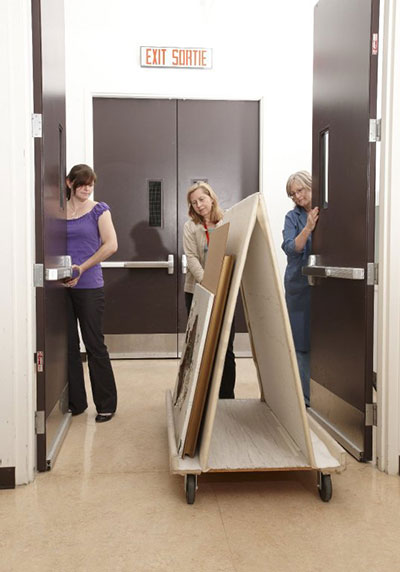
© Government of Canada, Canadian Conservation Institute. CCI 86568-0005
Figure 38. Framed and unframed paintings are moved on an A-frame cart. A cardboard sheet separates each piece.

© Government of Canada, Canadian Conservation Institute. CCI 86568-0001
Figure 39. A cart with pneumatic tires is used to move several objects. To dampen any damaging contact, the shelves were each lined with a foam sheet (white) and the shelf rims were padded with (black) plastic foam pipe insulation.
If objects have been well wrapped and padded, they can be placed on unpadded carts, provided that they are secured in place to prevent movement. In most cases, padding the cart is more convenient. A robust, low-cushion padding material, such as carpet, will withstand heavy loads. Additional padding, such as soft foam (up to several centimetres thick, depending on the weight of the object) may be used to absorb vibration. All objects must be separated from each other by padding materials or rigid sheets.
The type and size of wheels will influence the smoothness of movement; larger wheels (127 mm [5 in.] in diameter) will go over cracks and defects in the floor more smoothly than smaller wheels. Pneumatic tires will reduce vibration (Figure 39) (Esser 2011).
Ensure security
Moving objects, even within a building, creates a certain security risk. To ensure maximum security:
- Move objects from one secure area to another and supervise at all times to prevent theft, vandalism or damage.
- Update the object file by indicating the new location.
Consult Agent of deterioration: thieves and vandals for more strategies on strengthening security measures for heritage collections.
Report damage
Reports should be made of any damage, preferably with photographs, and the appropriate staff member should be informed (e.g. collections manager, registrar, conservator, curator). Box or bag all pieces that come loose, identify the package and keep it with the object (e.g. box or bag the object together with the bag or box containing the detached pieces). If pieces are sharp or fragile, wrap each piece in tissue before packaging it. If breaks are in danger of being snagged and lifted, a cloth tape can be bound around the break, or a warning label tied or placed near the object.
Bibliography
Esser, K. “Art-works With an Unfixed Paint Layer on Paper: Guidelines for Handling and Transport.” Journal of Paper Conservation 12,2 (2011), pp. 13–24.
Canadian Conservation Institute. Rolled Storage for Textiles, revised. CCI Notes 13/3. Ottawa, ON: Canadian Conservation Institute, 2008.
Guild, S., and M. MacDonald. Mould Prevention and Collection Recovery: Guidelines for Heritage Collections. Technical Bulletin 26. Ottawa, ON: Canadian Conservation Institute, 2004.
Illes, V., B. Derion and D. Tingry. Guide de manipulation des collections. Paris, France: Somogy éditions d’art, 2004.
Kubiatowicz, R., and L. Benson. “Oh no! Ethnobotany. The Safe Handling and Storage of Hazardous Ethnobotanical Artifacts.” Collection Forum 18,1–2 (2003), pp. 59–73.
National Park Service. Hazardous Materials in Your Collection. (PDF format) Conserv O Gram 2/10. Washington, DC: National Park Service, August 1998.
National Park Service. How to Select Gloves: An Overview for Collections Staff. (PDF format) Conserv O Gram 1/12. Washington, DC: National Park Service, September 2010.
National Park Service. Guidelines for the Handling of Pesticide Contaminated Collections. (PDF format) Conserv O Gram 2/19. Washington, DC: National Park Service, January 2012.
Odegaard, N. A Guide to Handling Anthropological Museum Collections. Denver, CO: The Western Association for Art Conservation (WAAC), 1992.
Shelley, M., ed. The Care and Handling of Art Objects: Practices in the Metropolitan Museum of Art. New York, NY: The Metropolitan Museum of Art, 1987.
Sirois, J., J. Poulin, and T. Stone. “Detecting Pesticide Residues on Museum Objects in Canadian Collections – A Summary of Surveys Spanning a Twenty-Year Period.” Collection Forum 24,1-2 (Fall 2010), pp. 28–41.
Tsang, J. “Safe Handling of Plastics in a Museum Environment.” Western Association for Art Conservation (WAAC) Newsletter 32,2 (May 2010), pp. 16–22.
Warren, S. “Dealing With Radiation Hazards: The Luminous Dial Project at the Canada Science and Technology Museum.” Journal of the Canadian Association for Conservation 35 (2010), pp. 9–15.
© Government of Canada, Canadian Conservation Institute, 2018
Published by:
Canadian Conservation Institute
Department of Canadian Heritage
1030 Innes Road
Ottawa, ON K1B 4S7
Canada
Cat. No.: CH57-4/7-2-2018E-PDF
ISBN 978-0-660-28051-6